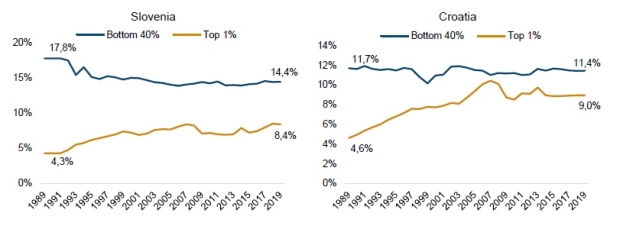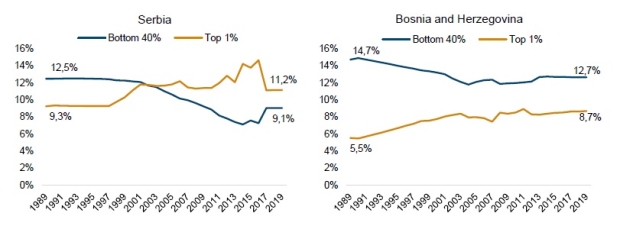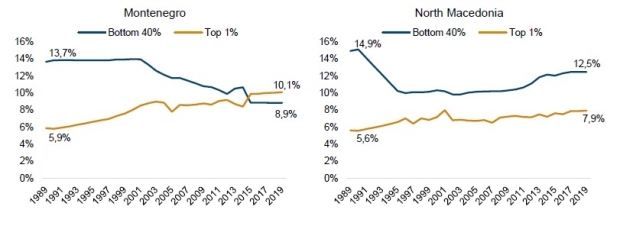Yugoslavia, 30 years on: Winners and losers from transition.
14 June 2021
All ex-Yugoslav republics experienced a notable increase in inequality over the past 30 years.
The transition from socialism to capitalism in the former Yugoslav republics has been marked by a notable increase in inequality. All six republics – Slovenia, Croatia, Serbia, Bosnia and Herzegovina, Montenegro and North Macedonia – have had similar trends, which can be summarised as follows.
First, the share of national income that ends up in the hands of the top 1% of the population increased markedly between 1989 and 2019 in all the republics. Slovenia, Croatia and Montenegro saw the most pronounced increases – of 4-5 percentage points (pp) of total national income. The rise was less intensive in Serbia and North Macedonia, at around 2 pp of national income. Bosnia and Herzegovina was in between, with an increase of around 3 pp.
National income going to the top 1% and the bottom 40% of the population, 1989-2019
(Pre-tax shares of national income, in %)
At the same time, the share of national income that ends up with the bottom 40% of the population has declined in all the republics. In Slovenia, Serbia and Montenegro, the decline was around 3-4 pp of total national income between 1989 and 2019. In Bosnia and Herzegovina and North Macedonia the drop was smaller, at around 2-2.5 pp. Only Croatia did not see a big contraction: the share of the bottom 40% there shrank by only 0.3 pp.
Finally, the increase in the top 1% share of income during this time mirrored the decline in the share of the bottom 40%. The income share of the remaining 59% of the population remained mostly stable. The sole exception was Croatia, where the increase in the share of the top 1% came primarily at the expense of the middle 59% of the population.
Source: World Inequality Database.
To sum up, the transition from socialism to capitalism in the ex-Yugoslav republics has redistributed national income from the bottom 40% to the top 1%.
This article first appeared in the wiiw Monthly Report, a regular wiiw publication containing brief articles on topical issues related to the economies in Central, East and Southeast Europe and CIS countries. It is regularly available only for wiiw members during an embargo period of six months. The June Special Issue on the 30th Anniversary of the Break-up of Yugoslavia is available for free.



